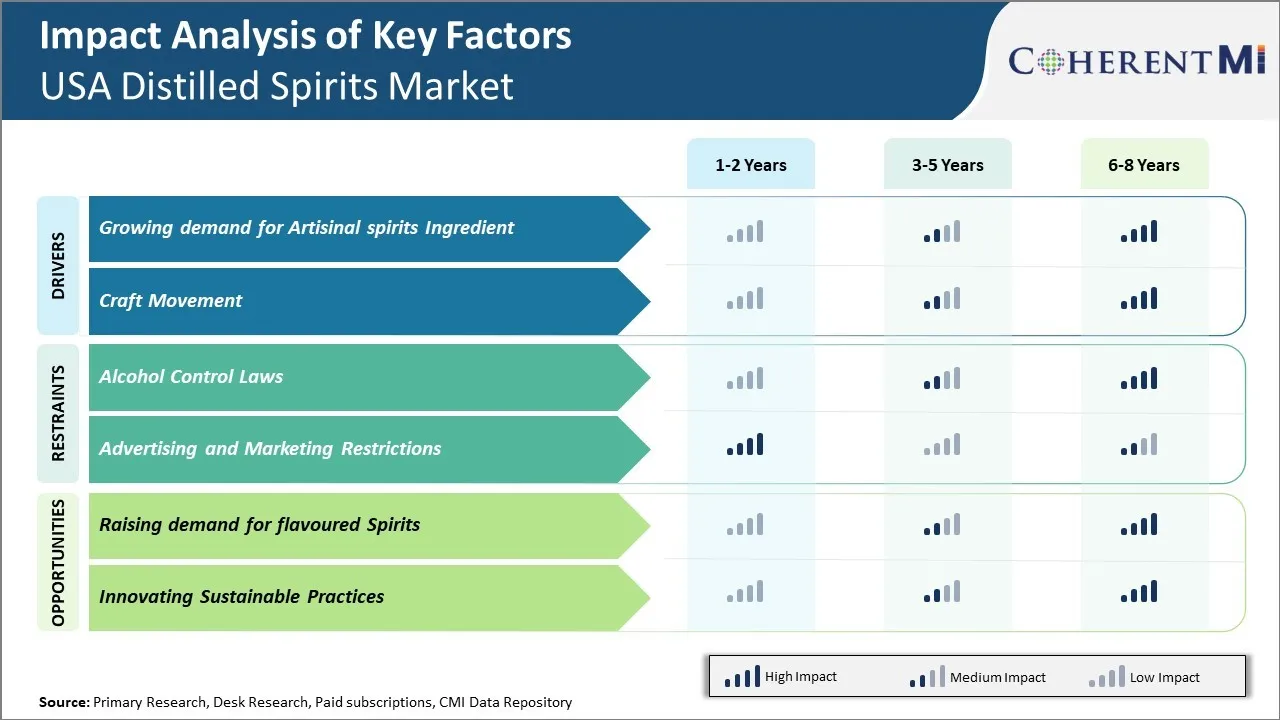United States Distilled Spirits Market Trends
Market Driver – Growing Demand for Artisanal Spirits Ingredient
The demand for artisanal spirits made with unique ingredients is driving significant growth in the United States distilled spirits market. Consumers are increasingly interested in premium and craft spirits that have more distinctive flavors derived from locally sourced botanicals. They are eager to support smaller American distilleries that produce limited batches using unconventional ingredients grown or foraged in specific regions.
This focus on novelty and authenticity has led to experimentation across the country as distillers explore the vast variety of plants indigenous to North America. Many are rediscovering native American traditions of utilizing wild plants in heirloom distilling processes. According to the U.S. Department of Agriculture, over 500 species of edible fruits, nuts and herbs grow wild across different states and are suitable for infusing into spirits (USDA 2022).
Distillers based in California, Oregon and Washington have been notable early adopters of using Pacific Northwest berries, nuts and roots such as huckleberries, hazelnuts and licorice root. Those in the Northeast also incorporate ingredients like cranberries, sassafras and fir tips indigenous to Appalachian forests.
Market Driver – Craft Movement
The rise of the craft spirits movement is positively impacting the growth of the United States distilled spirits market. Craft distillers offer innovative new products that appeal to changing consumer preferences. These small-batch products are often made from locally sourced ingredients and emphasize traditional production methods. As a result, craft spirits have developed a reputation for high quality that differentiates them from mass produced brands.
Many Americans have developed an interest in learning about the artisanal processes involved in crafting small-batch spirits. They are drawn to supporting small, independent distilleries in their local communities. Craft spirits allow consumers to directly engage with the producers and locations where their purchases are made. This interaction has made craft distilling an experiential industry that encourages travel and tourism. Distilleries offer tours and tastings experiences that have become a novelty cultural activity. According to the Distilled Spirits Council of the United States, visits to craft distilleries grew by over 15% per year between 2018-2021.
 Market Challenge – Alcohol Control Laws
Market Challenge – Alcohol Control Laws
The stringent alcohol control laws enforced by various states and the federal government present significant bottlenecks for the growth of the United States distilled spirits market. These regulations govern multiple aspects of production, distribution, sales, and marketing of distilled liquor products.
One of the major restraining factors is the ban or restrictions imposed on direct-to-consumer shipping of spirits from the producer to individual customers in many states. As of now, around 16 states completely prohibit direct shipping while 25 states allow it with various restrictions. This effectively blocks e-commerce and hampers the accessibility of products for local customers. It also raises transaction costs for smaller producers to distribute their products nationally.
Another challenge comes from the control states model followed by 17 states where state agencies have monopoly over wholesale and retail sales of distilled spirits. While the intention is to regulate alcohol consumption, it lacks free market competition. This discourages innovations as private businesses have little incentive to introduce new brands or tailor products according to changing customer preferences.
Market Opportunity – Rising Demand for Flavored Spirits
The demand for flavored spirits is rising rapidly in the United States distilled spirits market, presenting a major growth opportunity. Consumers, especially millennials and Generation Z, are showing a strong preference for spirits that come in a variety of flavors beyond the traditional ones. They are increasingly seeking new and exciting tastes as well as cocktails that match their flavor preferences.
Flavored spirits allow for greater experimentation and variety in drinks. Popular flavors include lemon, lime, orange, apple, cherry, cinnamon, vanilla and more. Ready-to-drink cocktails are also on the rise, combining spirits with mixers and flavors in convenient cans or bottles. For example, sales of spiked seltzers grew over 50% in 2021 according to data from IWSR Drinks Market Analysis (not a market research firm).
Spiced rums and flavored vodkas are additionally seeing a surge in demand. This rising passion for unique flavors plays right into the hands of innovative distillers. Producers are actively diversifying their portfolios to capitalize on this consumer trend.